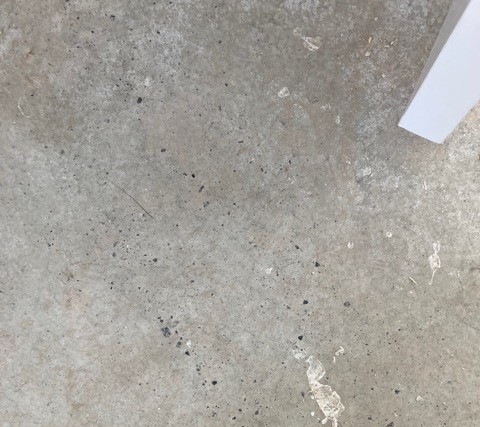Dealing with lignite

In this article, F. Ball technical representative Gary Kenworthy, provides a solution for dealing with the relatively uncommon problem of lignite.
While undertaking a site visit to advise on subfloor preparation prior to the installation of Luxury Vinyl Tiles (LVTs) in the ground-floor kitchens, utility rooms and WCs of several newly built semi-detached properties, each with an approximate area of 80m2, it was noted that the sand/cement screed was contaminated. There were also several cracks in the screeds in each plot.
Uncommon issue
Apart from splatters of paint and plaster, there were speckles of black contamination throughout. I suspected that this was lignite, a soft, low grade of coal, which is naturally present in some aggregate sources. Although it’s uncommon to find it, when it is present, it needs to be dealt with. A sample returned from site that was tested, by seeing if it could be used to mark a piece of paper, confirmed this.
A routine moisture test also indicated that subfloor Relative Humidity (RH) levels in the utility rooms of two of the properties were around the limit for installing resilient floorcoverings without a moisture management solution in place, with one giving a reading of 74% and the other 80%. BS 8203, Code of practice for installation of resilient floor coverings, stipulates that subfloor moisture levels must be lower than 75% RH in these situations.
When conducting any flooring installation, it’s important to ensure the subfloor is free of contaminants that may interfere with the adhesion of subsequently applied subfloor preparation products and floorcoverings. A particular problem with lignite is that it is sensitive to moisture – particles that absorb water can expand and protrude from the subfloor, so the installation could not proceed as normal. Neither could we recommend applying a waterproof surface membrane while the screed was still damp. However, once the screed had dried sufficiently, a waterproof surface membrane could be applied to isolate the lignite from the moisture in any subsequently applied floor smoothing compounds.
Initial steps
Therefore it would first be necessary to allow the screed to dry naturally to a point where a moisture test indicated that subfloor RH levels were below 75%. The contractor would then need to mechanically remove paint and other contaminants from the sand/cement screeds before vacuuming to leave a clean, dust-free, micro-textured surface.
Cracks in the concrete would need to be vacuumed to remove any dust and debris before being repaired. This could be achieved with a suitable repair compound, such as F. Ball’s Stopgap 400, providing that they were static. It was recommended to wet the floor beforehand to have the effect of priming – preventing moisture being drawn from the repair compound and inhibiting strength build up.
A single coat of Stopgap F77 waterproof surface membrane could then be applied to create a barrier between the lignite and moisture in subsequently applied subfloor preparation products. It should be applied using a 1.5mm x 5mm v-notched trowel, before rolling with a pre-coated roller to achieve a continuous pinhole-free finish.
Once the waterproof surface membrane had cured, it was recommended that the surface was primed using F. Ball’s Styccobond P141. It is specially designed to promote the application characteristics of smoothing compounds when applied to non-absorbent surfaces, including waterproof surface membranes. When the primer was dry, contractors could apply a minimum 3mm thickness of Stopgap 1200 smoothing compound and allow it to dry to create a perfectly smooth base for floorcoverings.
Adhesive recommendation
Finally, we advised that LVTs were installed according to the manufacturer’s instructions using F. Ball’s Styccobond F49 temperature tolerant pressure sensitive adhesive, providing this is listed as compatible in our Recommended Adhesives Guide (RAG®).
The use of a high temperature grade adhesive was specified because of the potential for large patio doors in the kitchens to cause solar gain. High temperatures or extreme temperature fluctuations as a result of solar gain can cause floorcoverings to expand and contract significantly, which may lead to unsightly tenting in floorcoverings and gapping at the edges of LVTs over time.
Styccobond F49 is a solvent-free, water-based adhesive that develops the ultra-high bond strength to hold floorcoverings firmly in place when exposed to temperature fluctuations from -20°C up to +60°C. Its pressure sensitive characteristics would also help with the positioning and alignment of LVTs.
The good news was that this sticky situation was resolved and works could commence again within 48 hours, and the project has now been completed.
Gary Kenworthy is F. Ball technical representative for the North West.
F. Ball’s regional technical representatives provide advice to flooring contractors on how to get the most out of F. Ball products, including conducting site visits and producing case-specific reports advising on the best course of action for particular flooring projects. Find out who your technical representative is here.
